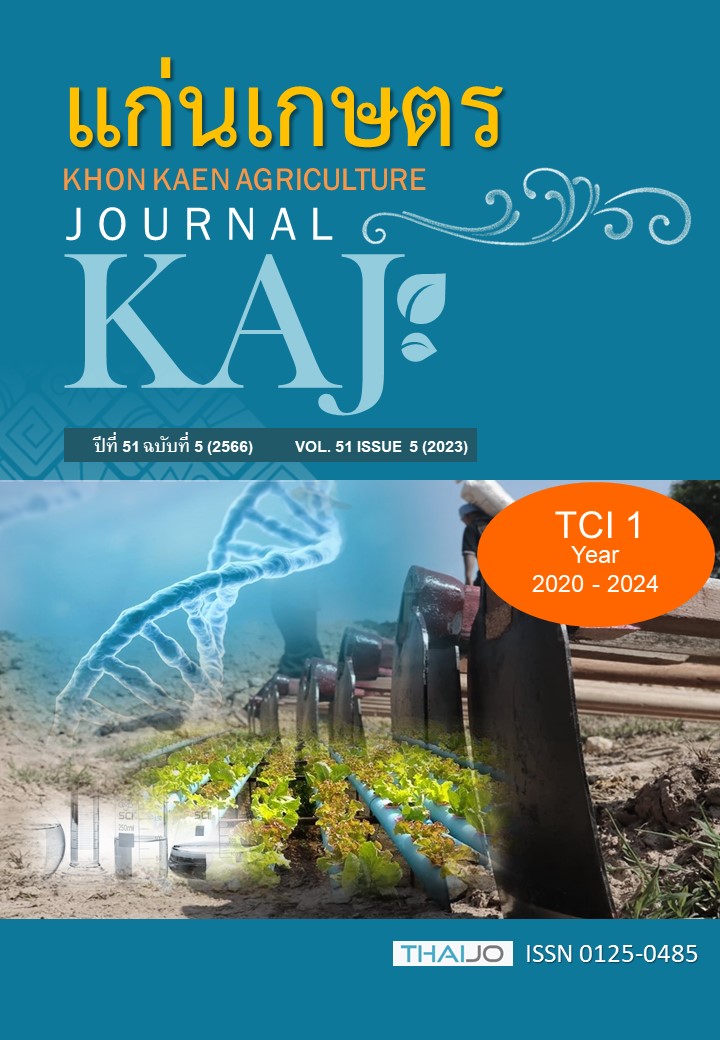อิทธิพลของกรงและแหล่งของแสง ต่อการผสมพันธุ์และการวางไข่ของแมลงโปรตีน Hermetia illucens L. (Diptera: Stratiomyidae)
Main Article Content
บทคัดย่อ
แมลงโปรตีน (BSF: Hermetia illucens L.) เป็นแมลงที่มีความสำคัญในโมเดลระบบเศรษฐกิจทางชีวภาพ-หมุนเวียน-สีเขียว (BCG economy model) โดยตัวหนอนสามารถกินเศษเหลือทิ้งอินทรีย์ และเปลี่ยนเป็นชีวมวลที่มีโปรตีนที่ดีสามารถใช้เป็นโปรตีนทางเลือกที่สำคัญในอุตสาหกรรมอาหารสัตว์ การผลิตแมลงโปรตีนที่มีประสิทธิภาพจะต้องได้ไข่คุณภาพดี มีปริมาณสม่ำเสมอและต่อเนื่องตลอดปี ซึ่งควรมีกรงผสมพันธุ์ที่เหมาะสมและแสงที่เป็นปัจจัยสำคัญต่อการผสมพันธุ์และวางไข่ของแมลง ดังนั้นวัตถุประสงค์ของการศึกษานี้ คือ เพื่อเปรียบเทียบกรงผสมพันธุ์และวางไข่ของแมลง 2 รูปแบบ ระหว่างการใช้มุ้งตาข่ายกันแมลงสำเร็จรูป (1.8x2x1.5 ม.) และกรงท่อพีวีซี (1x1x1.8 ม.) และการเปรียบเทียบระหว่างการใช้แสงอาทิตย์และแสงจากหลอดไฟ UVA ผลการทดลองพบว่ากรงท่อพีวีซีได้น้ำหนักไข่ทั้งหมด 12.16 ก. มากกว่ามุ้งสำเร็จรูป (7.58 ก.) อย่างมีนัยสำคัญทางสถิติ (P<0.05) จำนวนเพศเมียที่วางไข่ของกรงท่อพีวีซี 37.13% มากกว่าของมุ้งตาข่ายกันแมลงสำเร็จรูป (24.85%) อย่างมีนัยสำคัญยิ่งทางสถิติ (P<0.01) การเปรียบเทียบผลของการใช้แสงอาทิตย์และแสงจากหลอดไฟ UVA พบว่า แสงจากหลอดไฟ UVA ให้น้ำหนักไข่ทั้งหมด 0.27 ก. มากกว่าการใช้แสงอาทิตย์ (0.09 ก.) อย่างมีนัยสำคัญยิ่งทางสถิติ (P<0.01) อย่างไรก็ตามผู้เลี้ยงสามารถใช้กรงผสมพันธุ์และวางไข่ได้ทั้งสองรูปแบบ โดยปรับความหนาแน่นของตัวเต็มวัย 1,000 ตัว/ลบ.ม.
Article Details

อนุญาตภายใต้เงื่อนไข Creative Commons Attribution-NonCommercial-NoDerivatives 4.0 International License.
เอกสารอ้างอิง
บวรทัช สิงห์เดช. 2566. ปัจจัยที่มีผลต่อการผสมพันธุ์และการวางไข่ของแมลงโปรตีน (black soldier fly: Hermetia illucens L.). วิทยานิพนธ์ปริญญาวิทยาศาสตรมหาบัณฑิต มหาวิทยาลัยขอนแก่น. ขอนแก่น.
Banks, I.J., W.T. Gibson, and M.M. Camero. 2014. Growth rates of black soldier fly larvae fed on fresh human faeces and their implication for improving sanitation. Tropical Medicine and International Health. 19:14-22.
Beesigamukama, D., B. Mochoge, N.K. Korir, K.K.M. Fiaboe, D. Nakimbugwe, F.M. Khamis, S. Subramanian, M.M. SWangu, T. Dubois, S. Ekesi, and C.M. Tanga. 2021. Low-cost technology for recycling agro-industrial waste into nutrient-rich organic fertilizer using black soldier fly. Waste Management. 119(1): 183–194.
Diener, S., C. Zurbrügg, F. Roa Gutiérrez, D.H. Nguyen, A. Morel, T. Koottatep, and K. Tockner. 2011. Black soldier fly larvae for organic waste treatment – prospects and constraints, pp. 52(1-8). Proceedings of the Waste Safe 2011 – 2nd International Conference on Solid Waste Management in the Developing Countries 13-15 February 2011, Khulna, Bangladesh.
Heussler, C. D., A. Walter, H. Oberkofler, H. Insam, W. Arthofer, B.C. Schlick-Steiner, and F.M. Steiner. 2018. Influence of three artificial light sources on oviposition and half-life of the black soldier fly, Hermetia illucens (Diptera: Stratiomyidae): Improving small-scale indoor rearing. PLoS One. 13(5): 1-10.
Jucker, C., M.G. Leonardi, I. Rigamonti, D. Lupi, and S. Savoldelli. 2019. Brewery’s waste streams as a valuable substrate for black soldier fly Hermetia illucens (Diptera: Stratiomyidae). Journal of Entomological and Acarological Research. 8876(51): 87-94.
Julita, U., L.L. Fitri, R.E. Putra, and A.D. Permana. 2020. Research article mating success and reproductive behavior of black soldier fly Hermetia illucens L.(Diptera, Stratiomyidae) in tropics. Journal of Entomology. 17(3): 117-127.
Lalander, C., S. Diener, M.E. Magri, C. Zurbrügg, A. Lindström, and B. Vinnerås. 2013. Faecal sludge management with the larvae of the black soldier fly (Hermetia illucens) from a hygiene aspect. Science of the Total Environment. 458: 312-318.
Liu, Z., A.J. Najar-Rodriguez, M.A. Minor, D.I. Hedderley, and P.C. Morel. 2020. Mating success of the black soldier fly, Hermetia illucens (Diptera: Stratiomyidae), under four artificial light sources. Journal of Photochemistry and Photobiology B: Biology. 205: 1-8.
Martínez-Sánchez, A., C. Magaña, M. Saloña, and S. Rojo. 2011. First record of Hermetia illucens (Diptera: Stratiomyidae) on human corpses in Iberian Peninsula. Forensic Science International. 206: 76-78.
Myers, D.R. 2013. Solar Radiation Practical Modeling for Renewable Energy Applications. CRC Press. 212 p. https://doi.org/10.1201/b13898.
Nguyen, T.T.X., J.K. Tomberlin, and S. Vanlaerhoven. 2015. Ability of black soldier fly (Diptera: Stratiomyidae) larvae to recycle food waste. Environmental Entomology. 44(2): 406–410.
Oonincx, D. G. A. B., N. Volk, J.J.E. Diehl, J.J.A. Van Loon, and G. Belušič. 2016. Photoreceptor spectral sensitivity of the compound eyes of black soldier fly (Hermetia illucens) informing the design of LED-based illumination to enhance indoor reproduction. Journal of insect physiology. 95: 133-139.
Park, K., W. Kim, E. Kim, K.W. Kwak, J.Y. Choi, and S. Lee. 2016b. Oviposition site preference in black soldier fly, Hermetia illucens (Diptera: Stratiomyidae), in artificial rearing system. International Journal of Industrial Entomology. 33(2): 54–8.
Sheppard, D.C., G.L. Newton, S.A. Thompson, and S. Savage. 1994. A value-added manure management-systemusing the black soldier fly. Bioresource Technology. 50: 275–279.
Sheppard, D.C., J.K. Tomberlin, J.A. Joyce, B.C. Kiser, and S.M. Sumner. 2002. Rearing methods for the black soldier fly (Diptera: Stratiomyidae). Journal of Medical Entomology. 39(4): 695-698.
Spranghers, T., M. Ottoboni, C. Klootwijk, A. Ovyn, S. Deboosere, B. Meulenaer, J. De Michiels, M. Eeckhout, P. De Clercq, and S.De Smet. 2017. Nutritional composition of black soldier fly (Hermetia illucens) prepupae reared on different organic waste substrates. Journal of the Science of Food and Agriculture. 97(8): 2594-2600.
Tomberlin, J.K., and D.C. Sheppard. 2001. Lekking behavior of the black soldier fly (Diptera: Stratiomyidae). Florida Entomologist. 84: 729-730.
Tomberlin, J.K., and D.C. Sheppard. 2002. Factors influencing mating and oviposition of black soldier flies (Diptera: Stratiomyidae) in a colony. Journal of Entomological Science. 37(4): 345-352.
Trinh, T.Q., H.T.H. Nguyen, T.T.H. Nguyen, T.T.L. Tran, H.T.T. Nguyen, and T.T.X. Nguyen. 2020. Production of biofertilizer from black soldier fly larvae and its impact on soil nutrients, enzyme activities, and rice growth. Journal of Soil Science and Plant Nutrition. 20(3): 795-807.
Wang, Y.S., and M. Shelomi. 2017.Review of black soldier fly (Hermetia illucens) as animal feed and human food. Foods. 91(6): 1-23.


